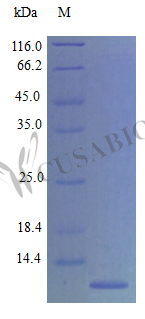Recombinant Mouse Eotaxin protein (Ccl11) is expressed in E. coli and represents the full length of the mature protein, covering the 24-97 amino acid region. This tag-free protein achieves a purity level exceeding 96%, as confirmed by SDS-PAGE analysis. It appears to be fully biologically active, with chemotaxis bioassays demonstrating activity in the 100-1000 ng/ml range with purified eosinophils. The endotoxin level is maintained below 1.0 EU/µg, as measured by the Limulus Amebocyte Lysate (LAL) method.
Eotaxin is a chemokine primarily involved in recruiting eosinophils—a type of white blood cell implicated in allergic reactions and asthma. It plays what appears to be a crucial role in the inflammatory response by guiding eosinophils to sites of inflammation. The protein's activity is essential for studying eosinophil behavior. It may also help researchers explore therapeutic strategies targeting eosinophilic inflammation in various research settings.
Potential Applications
Note: The applications listed below are based on what we know about this protein's biological functions, published research, and experience from experts in the field. However, we haven't fully tested all of these applications ourselves yet. We'd recommend running some preliminary tests first to make sure they work for your specific research goals.
1. Eosinophil Chemotaxis Assays
This recombinant mouse eotaxin protein can serve as a positive control or standard in chemotaxis assays to study eosinophil migration patterns. Given its confirmed biological activity in the 100-1000 ng/ml concentration range using purified eosinophils, researchers can establish dose-response curves and validate experimental conditions. The high purity (>96%) and low endotoxin levels make it suitable for cell-based assays where contamination could interfere with migration responses. This application appears particularly valuable for investigating eosinophil recruitment mechanisms in inflammatory disease models.
2. Receptor Binding and Interaction Studies
The biologically active eotaxin protein can serve as a ligand in binding assays to study its interactions with cognate receptors such as CCR3. Researchers might use this protein in competitive binding experiments, surface plasmon resonance studies, or fluorescence polarization assays to characterize receptor-ligand kinetics. The tag-free nature of the protein suggests that binding studies should reflect native protein interactions without potential interference from fusion tags. Such studies may provide insights into the molecular basis of eotaxin-mediated signaling pathways.
3. Antibody Development and Validation
This recombinant mouse eotaxin can be used as an immunogen for generating specific antibodies or as a standard for validating existing antibodies. The high purity and confirmed biological activity suggest that antibodies developed against this protein will recognize the native, functional form of eotaxin. Researchers can use this protein in ELISA development, Western blot validation, and immunoassay standardization. The low endotoxin content makes it suitable for immunization protocols in antibody production workflows.
4. In Vitro Inflammatory Response Modeling
The biologically active eotaxin protein can be used in cell culture systems to model inflammatory responses and study the effects of eosinophil recruitment on other cell types. Researchers might use this protein to investigate crosstalk between eosinophils and other immune cells, epithelial cells, or fibroblasts in co-culture experiments. The defined concentration range for biological activity allows for controlled experimental conditions to study dose-dependent cellular responses. This application is likely valuable for understanding the role of eotaxin in inflammatory cascades and tissue remodeling processes.
5. Pharmacological Screening Assays
This recombinant protein can serve as a tool compound in screening assays to identify potential inhibitors or modulators of eotaxin-mediated responses. Researchers might use it in high-throughput screening platforms to test compound libraries for their ability to block eotaxin-induced eosinophil chemotaxis. The consistent biological activity and high purity make it suitable for generating reproducible results across multiple screening campaigns. Such applications may contribute to the discovery of research tools for studying eosinophil biology and inflammatory processes.




